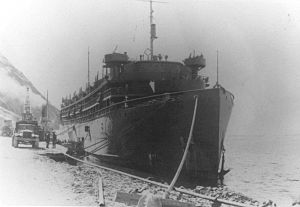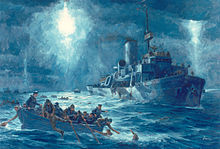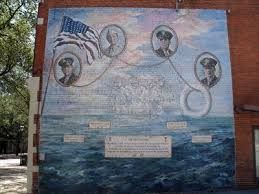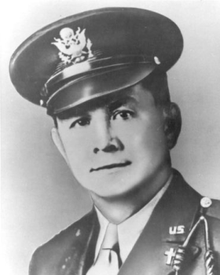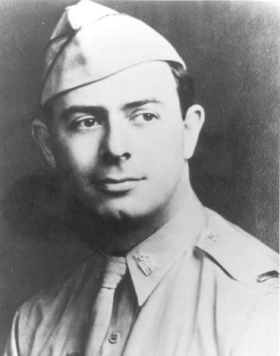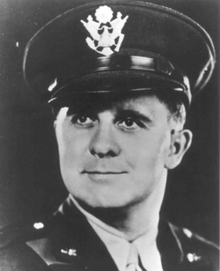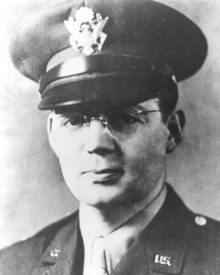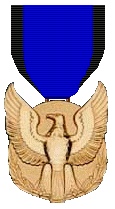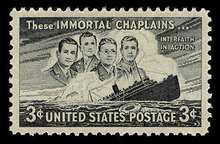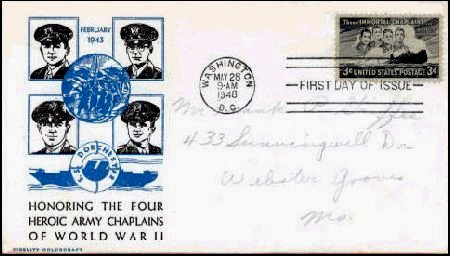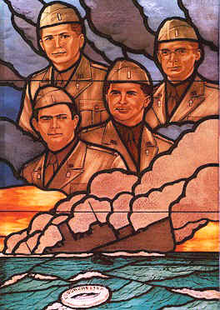Today, several religious denominations in the USA commemorate the day as "Four Chaplains Day"
Indeed, the US Senate proclaimed February 3, 1998 as Four Chaplains Day, and it is celebrated in the liturgy of the US Episcopal Church as a feast day. But what's the deal?
Well, the four chaplains have names, which I will come to. On 23 January 1943, an American passenger ship, the SS Dorchester, left New York, in Convoy SG19, escorted by three US Coast Guard cutters. Bound for Greenland.
There were about 900 passengers and crew, including approx 750 US Army soldiers.
On 3 February (this was a very slow convoy), the SS Dorchester was torpedoed by German U-boat U-223 https://en.wikipedia.org/wiki/German_submarine_U-223
The Dorchester was struck by a torpedo at about 12:55am, and the damage took out the electrical system on the Dorchester. The main boiler was out, and there was not enough steam to even blow the Abandon Ship alarm.
The ship listed severely to the side making the port side lifeboats useless. The water was so cold that hypothermia was killing quickly. Several lifeboats capsized from overloading. Many soldiers were trapped below
Among the soldiers embarked were 4 Army Chaplains, all new to the Army, all with the rank of 1st Lieutenant. The 4 Chaplains instituted an orderly evacuation, and helped many wounded men to safety.
The Chaplains took charge of distributing life jackets. When the jackets ran out, they gave up their own life jackets. They helped as many men as they could to the lifeboats.
The four chaplains went to their death in a cold, watery grave.
The air temperature was 2 deg C, the water temp was 1 deg C. Of the 904 men on the Dorchester, the US Coast Guard Cutter Escanaba saved 132 men and the Cutter saved 97
Rev George L. Fox was the eldest of the chaplains, aged 42. He was a war hero in his own right already, having been wounded in WW1 and decorated with both the Silver Star and the Croix de Guerre as an enlisted medic.
Rev/1LT Fox was originally from Pennsylvania and was an ordained minister in the Methodist church.
Rabbi Dr. 1LT Alexander D. Goode was a Jewish Rabbi from Brooklyn. He held a PhD from Johns Hopkins. He was 32 years old when the ship sank.
He'd also been a scoutmaster, leading a (for that era) rare mixed race, mixed religion scout troop with Protestant, Catholic, Jewish, black and white scouts. Troop 37 for you Scouting historians.
Rev/1LT Clark V. Poling was from Ohio. He was an ordained pastor in the Reformed Church in America. He was 32 years old.
Rev Poling had been a graduate of both Rutgers and Yale Divinity school. He left his post as a pastor of a church in Schenectady NY to join the Army as a Chaplain.
Father/1LT John Patrick Washington was a Catholic priest, originally from Newark New Jersey. He was 34 years old. He'd served several parishes in New Jersey before joining
These four men were considerably older than most of the men they saved. They were all volunteers, none of whom would have been conscripted in the war, as clergymen were exempted. They went to the sound of the cannons.
So, on February 3 every year these 4 chaplains are commemorated. They were posthumously awarded the Distinguished Service Cross.
Because of some technical minutiae, they were not deemed eligible for the Medal of Honor. Congress rectified this in 1960 and instituted the Four Chaplains Medal and awarded it posthumously, and granted it equal precedence to the Medal of Honor.
The Four Chaplains have been variously commemorated, both individually and collectively. The Postal Service honored them with a stamp.
There are numerous chapels around the US who commemorate these four men. This window is in the Pentagon.
End thread.

 Read on Twitter
Read on Twitter